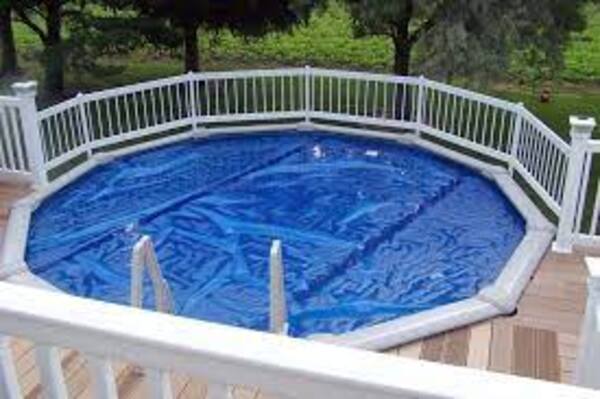The first thing any pool owner considers is how quickly and inexpensively they can heat their pool. This is true even if they have only the tiniest hint that summer is on the way. How quickly does a solar cover heat a pool, though? A solar pool cover can heat your pool by up to 5 degrees in 12 hours. Read this article and you can learn more about the solar cover.
What Is A Solar Cover
A solar cover is a sizable piece of polyethylene, vinyl, or polypropylene that resembles bubble wrap from a package. They are either round or rectangular and come in a range of sizes and colors. In-ground or above-ground pools, as well as spas, can use them to naturally heat the water.
Through the use of solar energy from the sun, this is accomplished. The quality and duration of the warranty are typically determined by the different millimeters they are available.
Because they are made of such a thick plastic material with UV inhibitors they are effective in areas most areas with a dry and/or windy climate. Your solar pool cover is placed over the water and appears to float.
This not only aids in keeping debris out but also has the potential to trap inside heat while absorbing extra heat from the sun.

Should I Cover My Entire Pool
This query has two possible responses. It is recommended to completely cover the swimming pool to get the most heating benefit from our solar cover. This also puts you at a bit more of a risk for algae growth if you do not properly take care of your swimming pool water.
This refers to circulation, brushing, and water chemistry. You might want to only cover 80–90% of the pool if these are issues you have.
What Size Cover Should I Get
No matter how your swimming pool is shaped, you should measure the longest part and the widest part. Proceed a little bit larger using those measurements.
Do not forget that we will be trimming the pool cover to fit. 12 x 24″, 15 x 30, 16 x 32, 18 x 36, and 20 x 40 are some examples of typical solar cover sizes. There are still other choices available, despite this.
How Does A Solar Cover Work
75% of a swimming pool’s heat loss is due to evaporation. By serving as a barrier between swimming pool water and the air, a solar cover reduces heat loss from evaporation. Specifically, using a solar cover can cut your swimming pool heating costs by up to 70%.
How Fast Does A Solar Pool Cover Heat Your Pool Water
Several elements, such as the type of solar cover you have and the weather, affect how quickly a solar pool cover will heat your pool. It’s challenging to reduce everything to a single solution as a result. However, on average, a solar pool cover will heat your pool by up to 5 degrees in 12 hours.
Type Of Solar Pool Covers
Solar pool covers come in three different varieties: solar blankets, solar rings, and liquid solar covers. While each of the three types is useful, they are not all equally useful.
Solar Blankets
Due to their appearance resembling bubble wrap, solar blankets are frequently referred to as bubble solar covers. They are composed of tiny thermal bubbles that cover the entire surface of the cover.
The bubbles keep your water warm and humid while absorbing UV rays. Preventing evaporation is a practical and affordable way to keep your water warm.
Solar Rings
Compared to solar blankets, solar rings are a much better option. You can use them for any type of pool, and they are lightweight and simple to use.
They function similarly to solar blankets, with the additional feature of magnets that keep them attached to one another so they stay in place.
Liquid Solar Covers
Modern technology has given us liquid solar covers, which are the most user-friendly of the three solar cover options. The liquid creates an imperceptible, non-toxic barrier that prevents heat from escaping the pool with just a simple pour into the water.
Liquid solar covers, as opposed to solar blankets and rings, work to maintain the pool’s temperature. They cannot help heat the pool. Due to this, liquid solar covers are 20–40% less efficient than solid covers.
Weather Conditions
The effectiveness of a solar pool cover will also be significantly influenced by the weather. As previously mentioned, solar covers cannot heat your pool on their own and should not be your main source of pool heating.
For them to function more efficiently, a pool heater or the sun must be used as a secondary heating source.
Alternatively, even if you continuously use a pool cover for a week while the sky is overcast, there’s a good chance that your pool may only have warmed up a few degrees.
The temperature at night is another consideration. Since nighttime is when water evaporation occurs most frequently, the solar pool cover will be less effective at preventing heat loss as the night grows colder.
Surface Coverage
The size of the surface area covered by a solar blanket contributes to its superior performance over a solar ring or liquid solar cover. The solar cover will heat and retain heat more effectively the more surface area it covers.
Even if you combine a solar cover with a pool heater, if your pool is not adequately covered, the heat will still escape through cool air temperatures and heat-robbing winds.
How Much Does A Solar Cover Cost
The cost of solar covers varies greatly, as with any product. The size of the pool and the solar cover’s thickness and color affect how much it costs. The majority of solar covers range in price from $50 to $300.
